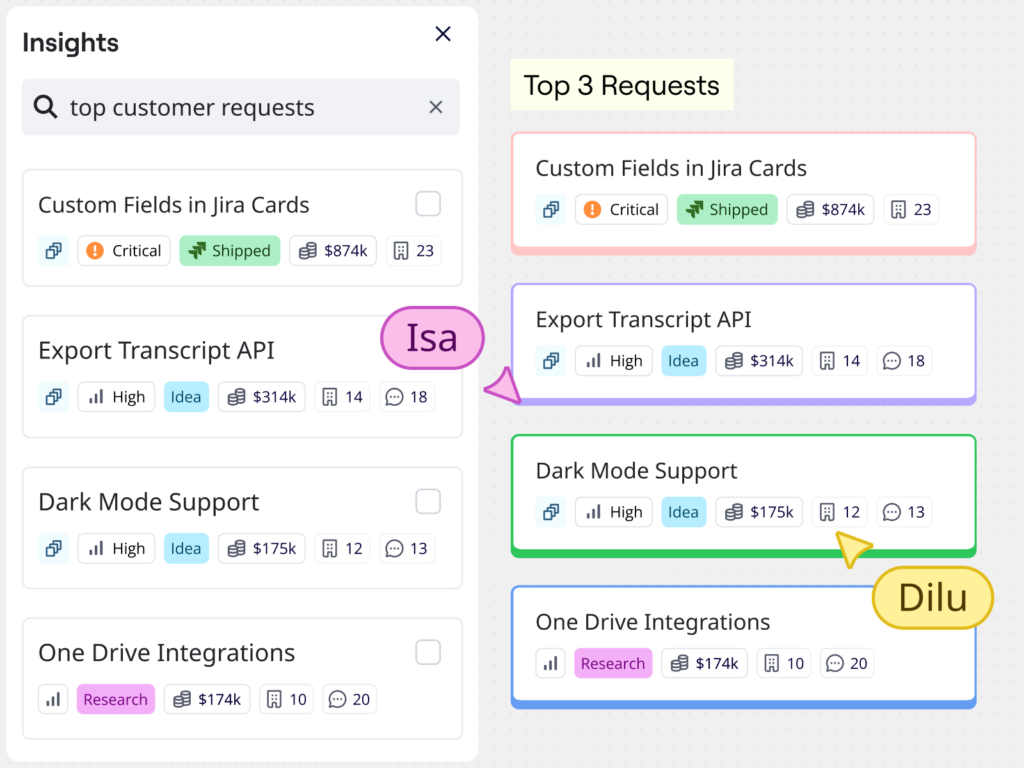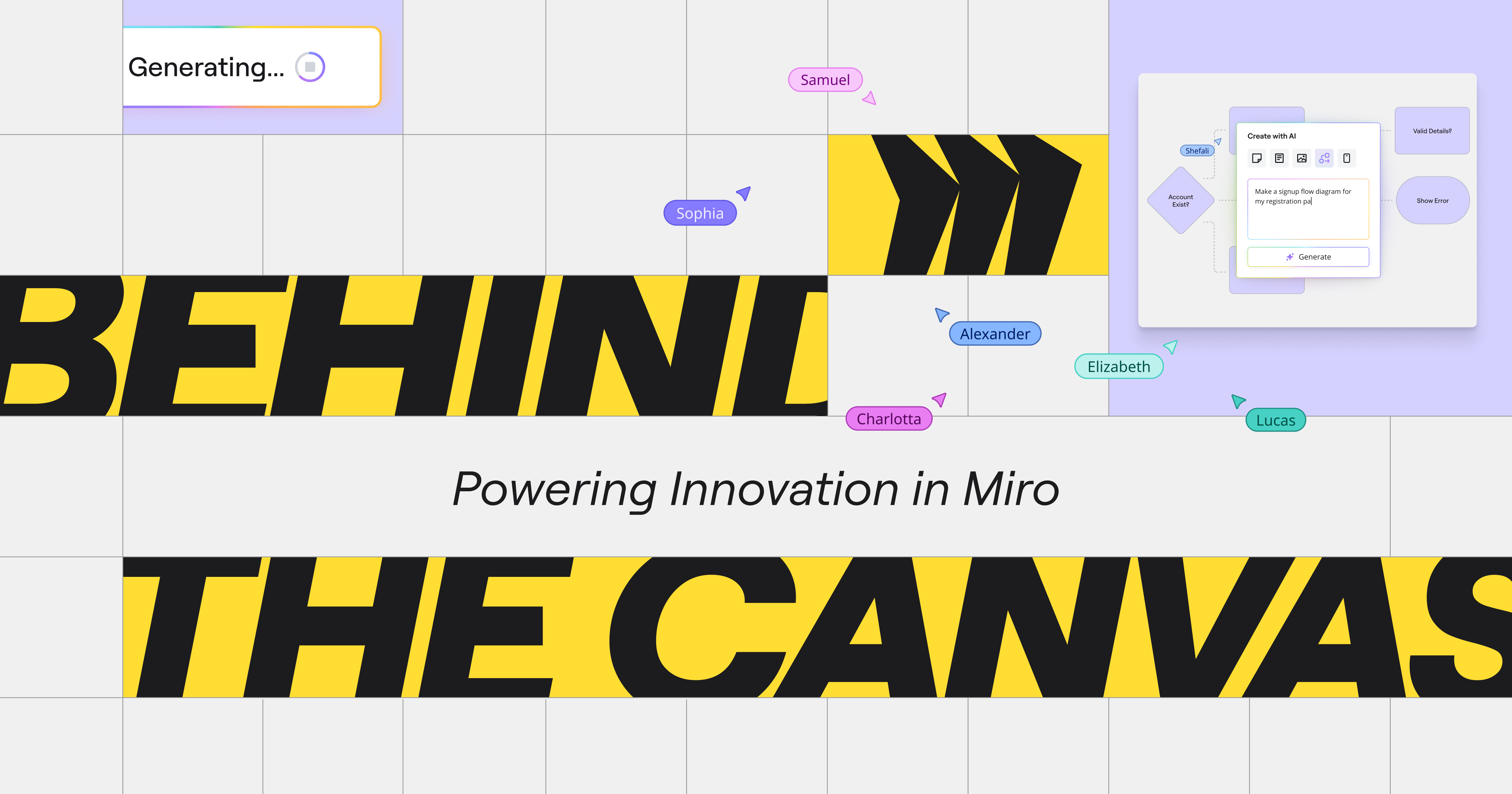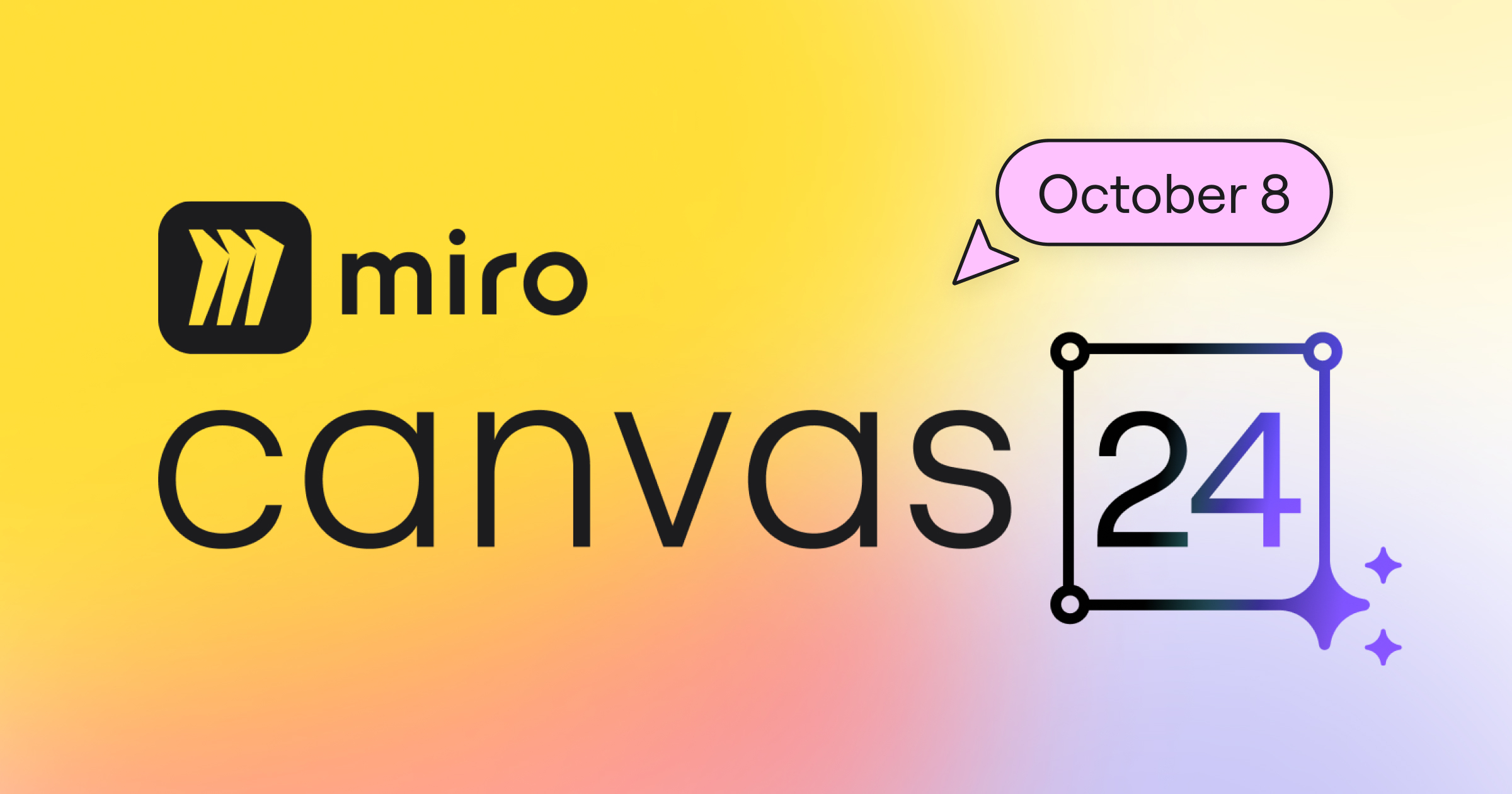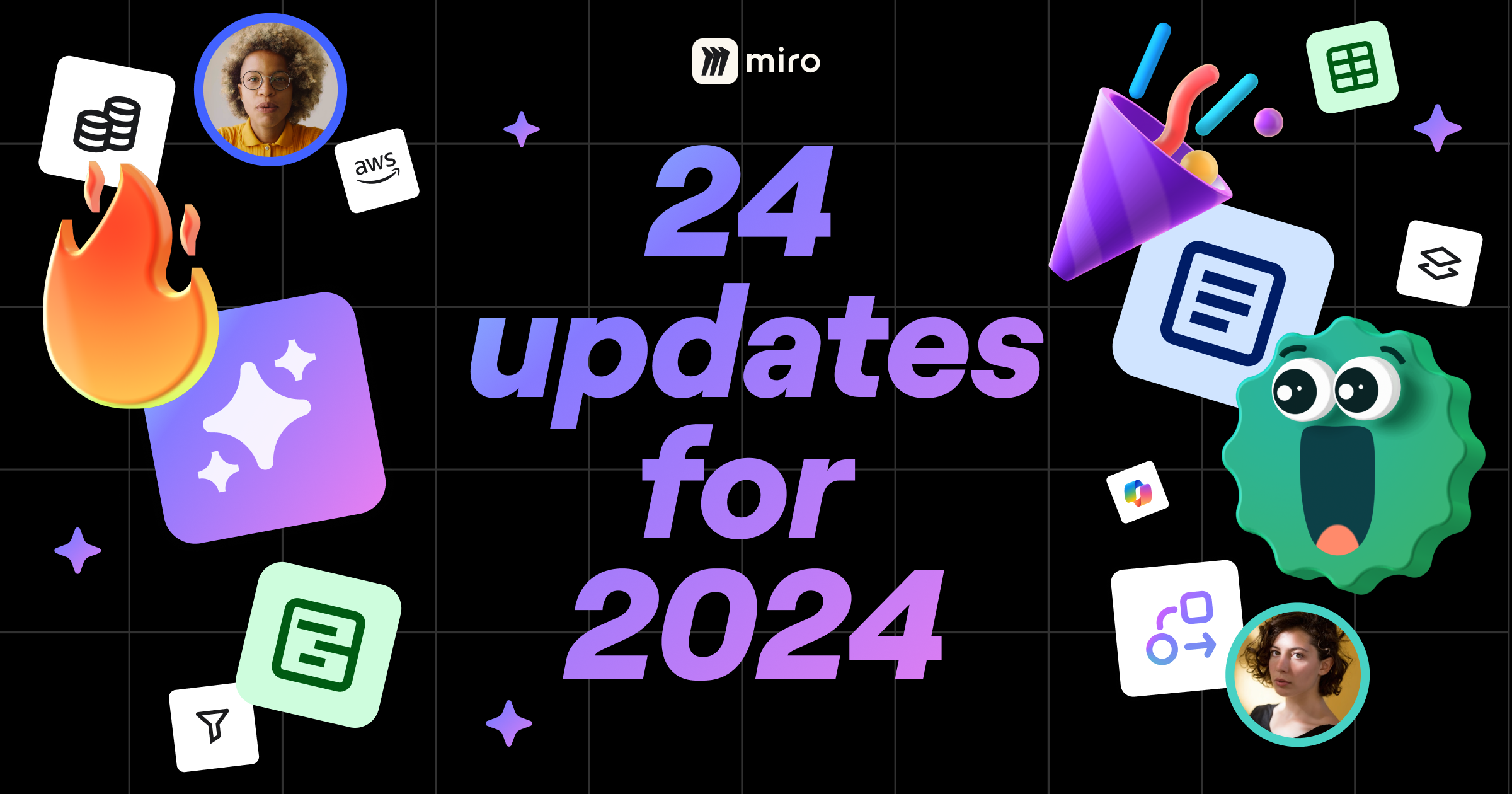At Miro, we believe in removing the barriers to innovation. That means helping teams navigate all the twists and turns across the entire lifecycle of their projects, so they can turn each obstacle into an opportunity for even greater impact.
So we’re thrilled to announce a number of new ways teams can put innovation to work.
Stay in the flow with even better Formats
One of the toughest parts of any innovation project is moving from the messy creativity of a brainstorm to the more structured stages of definition and delivery. Formats are Miro’s way of easing this transition – with Docs, Tables and Timelines that can be added to the canvas or opened in full screen focus mode to reduce distractions.
Now we’re adding two new formats: Diagrams and Slides.
The Diagrams format enables teams to build together on a canvas that’s actually optimized for the task with thousands of shapes and critical features like layers, snap-to-grid, and measurements. Of course you still have access to all the collaboration tools you’d expect, and we’ve also made sure that formats are interoperable, which means you can drag a diagram into a document and have it live there as a synced copy so it’s always up to date.
With Slides, you can make your workshop or meeting the hottest ticket for teammates with interactive presentations that can be created with a single click. It’s easy to rearrange frames, import a PDF from somewhere else, or use classic Miro experiences like dot voting and alignment scales to make it more engaging. Like our other formats, you can go full screen so you stay fully focused or collaborate on your storytelling straight on the canvas.
Finally, we’ve brought even more functionality to Tables. We know how many people rely on Tables to keep track of their projects – in fact more than half a million have been created since we launched the format just a few months ago. We’re excited to bring the learnings from all this activity to the next iteration of Tables, which includes:
- The ability to manage filters and adjust the data set based on what you need to look at
- A group function to sort projects by team
- A hide function to remove fields without deleting them.
Organize everything, find anything with Spaces
Each of these formats makes it easier to move through the different phases of work. But what’s really cool is when you put them all together and start creating end-to-end workflows. And that begins with Spaces.
Organizing content might not sound like the most exciting part of innovation, but we all secretly know that it’s critical to success. With Spaces, we’re making it easier to access relevant information so teams can drive projects from idea to outcome without wasting time searching for missing bits of context or switching between apps.
We’ve had a ton of valuable customer feedback on Spaces, so we’re excited to launch a bunch of new upgrades. First is the ability to create different sections within a space, so there’s even more structure and clarity to the way you organize your boards. And because we don’t want that structure to become too rigid we’ve made sure you can reorder these sections just by dragging them where they need to go, so your teams have total flexibility over how they organize their work.
Speaking of flexibility, you now also have the option to add third-party docs as artifacts in Spaces. That means you can embed content from other apps like Figma, Looker, Power BI, Google Workspace, and Microsoft 365. So you don’t have to jump around different tools or browser windows when you need to get something done.
Create intelligent workflows with AI
AI is at the center of everything we do at Miro, because it’s such an important part of helping teams move from idea to outcome faster. So it’s baked into pretty much all of these new features and formats.
For instance, AI to tables. We’ve added the option to create a table in Miro AI so that when you select a bunch of sticky notes from your latest brainstorm or feedback session, they’ll automatically become the perfect prompt for a table that tracks all your actions.It’s just one more way to move seamlessly between different phases of work, while making sure the entire team is fully onboard for the ride.
Then there’s AI prototyping. Not only can you create interactive wireframes from a text prompt, now you can easily update the prototype to match your brand. You don’t even have to set up a design system or do anything in the back end. You can select any image from your brand library or even just your website and Miro AI will match it.
“What’s powerful about these features is that they don’t need special training or great prompts. All the inputs you need are right there on the canvas; just select the relevant content Miro will do the rest.”
Here’s a familiar scenario: You need to make a change to a product but you don’t have the original design file so you can’t mark it up. You could write an explanation for the design team and hope they understand it. Or you could go from screenshot to prototype in a single click by uploading an image to the canvas, then using Miro AI to convert it to an editable prototype. Now you don’t have to tell the designers what you want – you can show them instead.
What’s powerful about these features is that they don’t need special training or great prompts. All the inputs you need are right there on the canvas; just select the relevant content and Miro will do the rest.
Make smarter decisions with Miro Insights
Behind every great innovation is a great insight. But figuring out what customers want is a huge challenge. Data is scattered across CRMs, project plans, and customer feedback. None of these sources are connected, so teams struggle to align on their most important priorities.

With Miro, you can already move from feedback to features faster by bringing all your people and data together in one place, transforming insights synthesis from a solo effort into a team sport. Now we’re excited to launch Miro Insights (formerly Cardinal) to help teams make even smarter decisions about what to build next.
Miro Insights doesn’t just bring your data sources together – it brings them to life, using AI to spotlight backlog recommendations, map feedback to product strategy, and even forecast the revenue value of future features. You can sign up for early access now.
Bring best practices to your projects with Blueprints
All of these updates and new releases are designed to help teams bring order to the chaos of daily work and get things done faster. But then we thought, ‘What if we took all these new capabilities and used them as the foundation for an even more structured way of working?’ Then we could take the guesswork out of important tasks and turn them into simple, repeatable processes instead.
And that’s how we created Blueprints.
Blueprints are ready-made Spaces that contain pre-populated boards for jobs like Roadmap Planning, Goal Setting and even AI Transformation. They’re fully customized and come with all of Miro’s regular collaboration and AI tools baked right in, as well as relevant formats deployed in just the right places. Think of them as building blocks that you can re-arrange or build on top of until you’ve created the perfect workflow for you.
There are 20 Blueprints available in Miro right now, including some from our amazing community, and we think they’re really going to accelerate the way works get done. We’ll be adding new ones all the time, and we’re excited to see what you build with them.
Get started with a Solutions Partner
We’re truly excited about this next step for Miro. We think it’s going to unlock a huge amount of value for any and every team that cares about collaborating on critical projects.
Almost all of these features can be found in the product today. But if you’re not sure where to start, Miro Solution Partners can provide tailored workshops, training, and implementation support to help you turn snail-paced innovation projects into fast-moving success stories. They can also help with broader AI, agile, or cloud transformation initiatives – including customizing new features to align with your specific business needs – so you see immediate value from your Miro investment.




